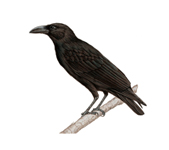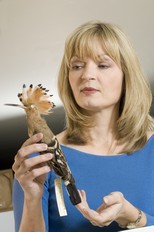
Illustration of the Banggai Crow by Agus Prijono
October 15, 2009

Illustration of the Banggai Crow by Agus Prijono

The Banggai Crow calls in the forest of Pelang Island in Indonesia. Photo by Philippe Verbelen
Known to science only by two specimens described in 1900, a critically endangered crow has re-emerged from hiding on a remote, mountainous Indonesian island thanks in part to a Michigan State University scientist.
The Banggai crow was believed by many to be extinct until Indonesian biologists finally secured two new specimens on Peleng Island in 2007. Pamela Rasmussen, a Michigan State University assistant professor of zoology and renowned species sleuth, provided conclusive verification.
An ornithologist who specializes on the birds of southern Asia, Rasmussen studied the two century-old specimens known as Corvus unicolor in New York’s American Museum of Natural History. She compared them to the new crow specimens in Indonesia’s national museum, to lay to rest lingering speculation that they were merely a subspecies of a different crow. The more common slender-billed crow, Corvus enca, also is found in the Banggai Islands, and likewise is all black.
“The morphometric analysis I did shows that all four unicolor specimens are very similar to each other, and distinctly different from enca specimens. We also showed that the two taxa differ in eye color — an important feature in Corvus — as well,” Rasmussen said. “Not only did this confirm the identity of the new specimens but also the specific distinctness of Corvus unicolor, which has also long been in doubt.”
The rediscovery was spearheaded by professor Mochamad Indrawan of the University of Indonesia, chair of the Indonesian Ornithologists’ Union, who conducted ecological field studies. He was assisted by collaborator Yunus Masala and by the Celebes Bird Club, members of which secured the new specimens that are now cataloged at the Museum Zoologicum Bogoriense in Java.
Before Indrawan and collaborators could publish their findings confirming the crow’s identity, other birdwatchers in the mountains of Peleng photographed and recorded Banggai crows, which Rasmussen said confirms the distinctiveness of the species.
Indrawan and Masala now have turned their efforts toward protecting the rare species, which is hunted by local residents. That includes making recommendations for protection of its forest habitat through sustainable agriculture methods and, perhaps, eco-tourism, to address the residents’ livelihood needs.
A photo of the Banggai crow debuts this week in volume 14 of the influential Handbook of the Birds of the World. “It was very exciting to see photos of such a rare species about which almost nothing is known, especially since the photos were of such high quality,” said Chief Editor Josep del Hoyo. He called the rediscovery “spectacular.”
Rasmussen, Indrawan and colleagues have submitted the detailed paper confirming the species’ rediscovery for publication. Rasmussen’s visit to Indonesia to take specimen measurements and make comparisons was made possible through a planning visit for a MSU Study Abroad program to Malaysia and Indonesia.

Pamela Rasmussen, an MSU assistant professor of zoology and assistant curator of mammalogy and ornithology at the MSU Museum. Photo by Kurt Stepnitz.
Rasmussen, who also is assistant curator of mammalogy and ornithology at the MSU Museum, is the author of the two-volume Birds of South Asia: The Ripley Guide. Her work on uncovering the ornithological frauds of British collector Col. Richard Meinertzhagen has won international attention, detailed in Nature, the May 2006 The New Yorker, and The Best American Science and Nature Writing 2007.
Information courtesy of a press release from Michigan State University.
Please click on the button below (not the one up top) to send in your museum donation.
Thank you.
About Loren Coleman
Loren Coleman is one of the world’s leading cryptozoologists, some say “the” leading living cryptozoologist. Certainly, he is acknowledged as the current living American researcher and writer who has most popularized cryptozoology in the late 20th and early 21st centuries.
Starting his fieldwork and investigations in 1960, after traveling and trekking extensively in pursuit of cryptozoological mysteries, Coleman began writing to share his experiences in 1969. An honorary member of Ivan T. Sanderson’s Society for the Investigation of the Unexplained in the 1970s, Coleman has been bestowed with similar honorary memberships of the North Idaho College Cryptozoology Club in 1983, and in subsequent years, that of the British Columbia Scientific Cryptozoology Club, CryptoSafari International, and other international organizations. He was also a Life Member and Benefactor of the International Society of Cryptozoology (now-defunct).
Loren Coleman’s daily blog, as a member of the Cryptomundo Team, served as an ongoing avenue of communication for the ever-growing body of cryptozoo news from 2005 through 2013. He returned as an infrequent contributor beginning Halloween week of 2015.
Coleman is the founder in 2003, and current director of the International Cryptozoology Museum in Portland, Maine.
Filed under Avian Mysteries, Breaking News, CryptoZoo News, Extinct, New Species